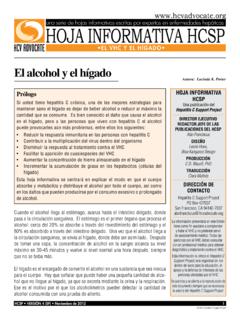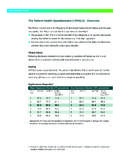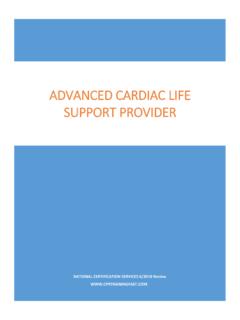Transcription of HCV FACT SHEET
1 HCV Advocate VERSION September 2018 2018 HCV Advocate Project1 Written by: Alan Franciscus, Editor-in-ChiefAn overview of ExtrahepaticManifestations of Hepatitis C CONTINUEDHCV FACT SHEETa series of fact sheets written by experts in the field of liver hepatitis C virus mainly affects the liver, but there are many other conditions that are associated with hepatitis C. extrahepatic manifestation means diseases or conditions that affect organs other than the liver. extrahepatic manifestations of hepatitis C can be found in the skin, eyes, joints, immune system, nervous system and kidneys. Some of these conditions cryoglobulinemia, for example are somewhat more common and well-documented, while others are infrequent or their association with hepatitis C has not yet been proven.
2 Several studies have found that between 70-74% of HCV patients experience extrahepatic manifestions. Some of the most common symptoms and conditions reported include fatigue, arthralgias (joint pain), paresthesias (feeling of numbness and tingling), myalgias (muscle pain), pruritus (severe itching), sicca syndrome (dryness of the mouth and eyes), insulin resistance, kidney disease, thyroid disease and many other conditions. Many of the conditions have in some way been related to cryoglobulin (an abnormal blood protein) production. Many extrahepatic manifestations occur after some years of infection. Early treatment treatment of HCV with direct-acting antiviral medications may prevent many of these extrahepatic manifestations .
3 Additionally, many extrahepatic manifestations are treated by treating the underlying cause which is hepatitis C. HCV FACT SHEETA publication of the HCV AdvocateThe information in this fact SHEET is designed to help you understand and manage HCV and is not intended as medical advice. All persons with HCV should consult a medical practitioner for diagnosis and treatment of information is provided by the HCV Advocate a nonprofit organization for HCV education, support and advocacyReprint permission is granted and encouraged with credit to the HCV INFORMATIONHCV AdvocatePO Box 15144 Sacramento, CA 95813alanfranciscus@ DIRECTOR, EDITOR-IN-CHIEF, HCV ADVOCATEAlan FranciscusDESIGNL eslie Hoex, Blue Kangaroo DesignPRODUCTIONL eslie Hoex extrahepatic manifestations OF HCV HCV Advocate VERSION 8 September 2018 2018 HCV Advocate2 HCV FACT SHEETa series of fact sheets written by experts in the field of liver disease extrahepatic manifestations OF HEPATITIS C overview of extrahepatic manifestations of Hepatitis C CONTINUED FROM PAGE 1It is important to remember that many of people with hepatitis C may never experience the more severe types of these extrahepatic manifestations .
4 However, if you believe that you may have any of these conditions talk to your medical provider for more information and diagnosis. If possible have your regular provider refer you to a provider who specializes in these types of is a common symptom of hepatitis C that is characterized as joint pain, but without inflammation of the joints that is associated with is a condition characterized as inflammation of the joints. Hepatitis C-related arthritis (HCVrA) is estimated to affect about 4% of the HCV population, but since most patients will not see an arthritis specialist the true number is likely higher. Hepatitis C-related arthritis is classified into two groups polyarthritis and mono-oligoarthritis. Polyarthritis is similar to rheumatoid arthritis but is less serious.
5 Mono-oligoarthritis affects the medium and large-sized joints typically the s Disease is a disease that presents as ulcerations in the eyes, mouth and genitals but can also affect any organ of the body and is caused by coagulation and destruction of arteries and is a condition believed to be associated with hepatitis C that causes premature graying of the hair, but is uncommon in people with hepatitis Vasculitis is a disorder that is characterized by inflammation and cell death of arteries in the brain. The cause of cerebral vasculitis is unknown, but it is thought to be caused by immune is one of the most common disorders associated with hepatitis C. Cryoglobulinemia is a blood disorder caused by abnormal proteins in the blood called cryoglobulins that precipitate or clump together when blood is chilled and then dissolve when warmed.
6 These proteins can be deposited in the small and medium sized blood vessels, which restricts blood flow and can lead to further problems. There is a blood test used to detect cryoglobulinemia, but it is important that the blood sample is kept at body temperature and handled carefully. Even though the markers for cryoglobulinemia are common in people infected with hepatitis C, many people with hepatitis C are not symptomatic. Those who are symptomatic can have mild, moderate or severe illness. Symptoms of cryoglobulinemia include red or purple blotching skin, and joint and generalized pain. Cryoglobulinemia can affect the skin, kidneys, nerves and joints. Conditions associated with cryoglobulinemia include vasculitis (inflammation of the blood vessels), peripheral neuropathy, Reynaud s Phenomenon (hands that are sensitive to cold temperature and turn white, red, blue), and Non-Hodgkin s lymphoma (cancer of the lymphatic tissues).
7 Treating cryoglobulinemia consists of treatment of the underlying disease (hepatitis C) as well as the administration of medications to suppress the immune system, and plasmapheresis (blood is taken from the body, filtered and returned to the body). CONTINUEDHCV Advocate VERSION 8 September 2018 2018 HCV Advocate3 HCV FACT SHEETa series of fact sheets written by experts in the field of liver disease extrahepatic manifestations OF HEPATITIS C overview of extrahepatic manifestations of Hepatitis C CONTINUED FROM PAGE 2 Lichen Planus is a skin disorder that is characterized by small elevated bumps or pimples and usually appears on flexor surfaces (the muscle that brings two bones together, causing flexion of the part) arms, trunk, genitals, nails and scalp.
8 Symptoms can include scaling, itching, hair loss, skin lesions, plaque, and pain. Hepatitis C-related lichen planus is caused by HCV replication in epithelial (skin) cells. Treatment consists of treating the underlying cause (hepatitis C), but treatment in managing or relieving symptoms of lichen planus has been inconsistent. Cortisone creams/ointments and cortisone injections are also used for managing the symptoms. Avoid substances that can trigger a flare-up of symptoms including alcohol, tobacco, spicy foods, peppermint, cinnamon, citrus type foods and stressful Abnormalities and diseases can be triggered by hepatitis C. Idiopathic Pulmonary Fibrosis is CONTINUEDF atigue is one of the most common symptoms of hepatitis C and can range from mild to moderate to debilitating.
9 It is thought that the fatigue is caused both by the body s immune response to hepatitis C as well as by the direct affect of the virus on the is a disorder characterized by aches, pain, stiffness, soft tissue tenderness, general fatigue and sleep disturbances. Pain is the most common symptom of fibromyalgia and it is usually confined to muscles and ligaments. Although fibromyalgia has not been linked to hepatitis C, it is a condition that is more commonly found in people with hepatitis C than in the general population. A comprehensive approach with many different healthcare providers (including the person suffering from Fibro) is the best Cardiomyopathy (HCM) is a form of a disease of the heart where enlargement and thickening develops in one part of the heart.
10 Immune Thrombocytopenic Purpura (ITP) is an autoimmune bleeding disorder caused when the blood doesn t clot. Symptoms of ITP are easy bruising of the skin as well as bruising under the skin that can be seen as red or purple dots on the skin. In severe cases bleeding from the nose, gums and gastrointestinal or urinary systems can occur. Insulin Resistance (IR) is a condition caused by the inability of cells to absorb glucose. This leads to the pancreas releasing more insulin so there is an excess amount of both glucose and insulin in the bloodstream. HCV can induce IR. Lichen Myxoedematosus (LM) is also known as papular mucinosis. LM is a rare chronic condition that has been linked to HIV infection, hepatitis C infection, and exposure to toxic oil and contaminated L-tryptophan.










